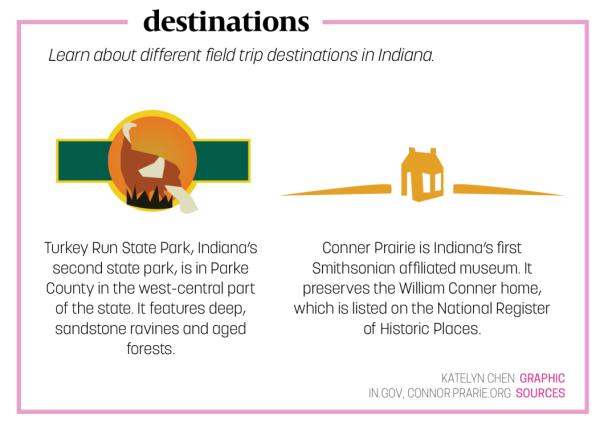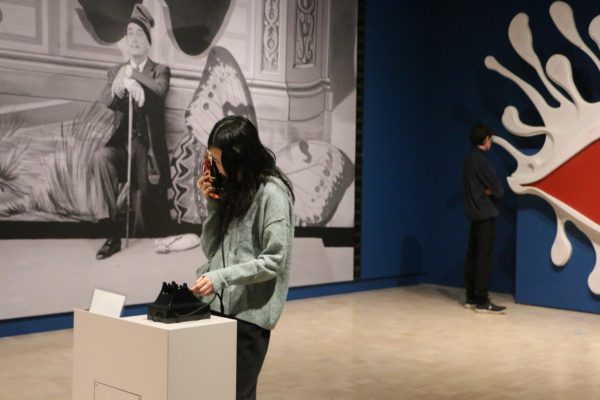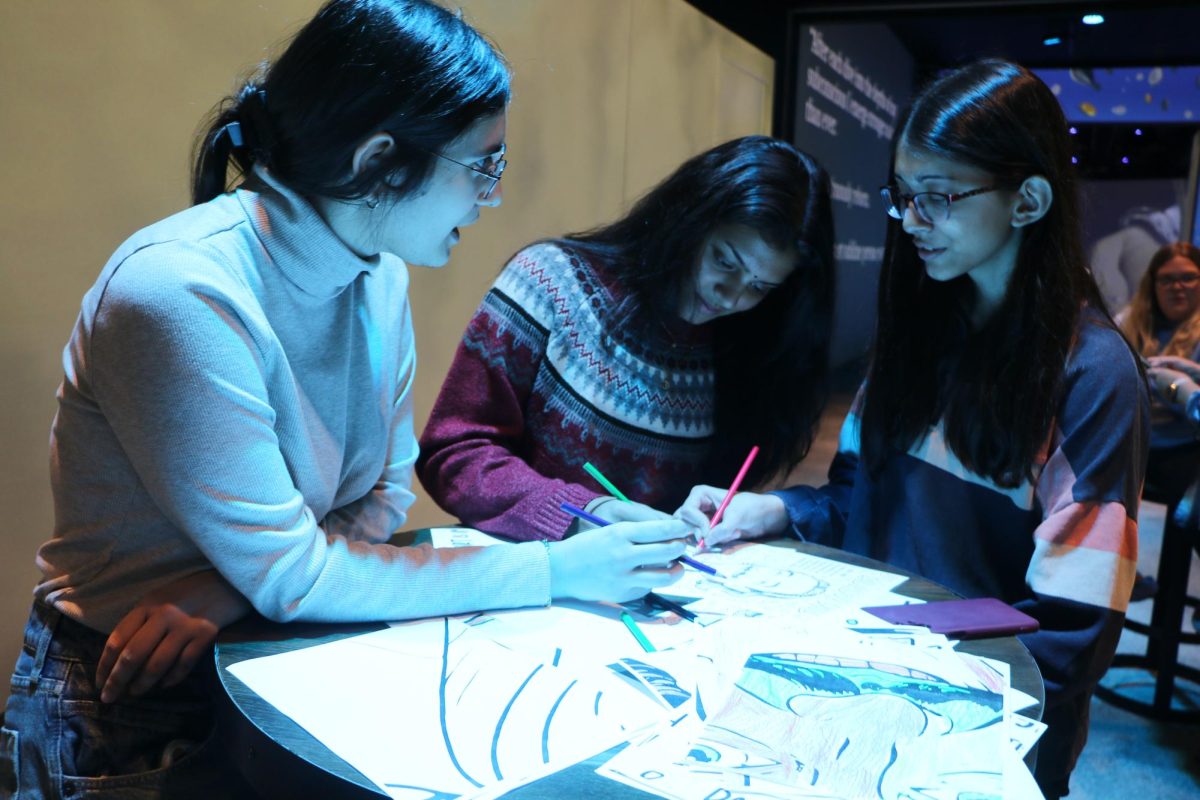As a group of students crowd the Salvador Dali LUME exhibit at the Newfields art museum on Oct. 23, senior Amna Ahmad said she wondered why classes at this school don’t offer more field trips. For Ahmad, field trips prove to be valuable educational experiences that take students out of the classroom and into the real world. Ahmad said they provide alternative methods to education, often enhancing the knowledge learned in a classroom setting and being an overall fun way to learn new things.
“Field trips allow the student to put what they have been learning into practice rather than using hypotheticals done in class; for example, the recent AP Spanish field trip to Newfields gave (students) an opportunity to see many famous works of art from hispanophone countries rather than reading about them out of a textbook or watching a video,” Ahmad said. She said sometimes videos and lectures seem boring or like “busy-work.”
Ahmad is one of many students who value the educational opportunities field trips provide. In fact, the educational value of field trips is nearly indisputable. According to Brookings.edu, field trips improve testing scores in students. In addition, they diversify student opinions and foster a degree of open mindedness. Furthermore, a study by Education Next showed that 88% of students retained factual information learned on museum tours — further solidifying the role of field trips in supplementing classroom learning.
Learning beyond the textbook
According to Kaden Petrites, another attendee of the AP Spanish Language field trip and senior, out-of-school excursions are a more fun way of learning information than in a traditional classroom setting.

“Field trips are powerful learning tools because of their ability to connect concepts in the classroom to real-world experiences,” Petrites said. “By immersing students in environments where they can use their senses, field trips can make abstract ideas become more tangible to the students’ understanding. For example, a visit to a natural history museum can enhance certain lessons in biology or earth science. The information presented makes everything in the classroom more vivid to (students).”
Petrites is not alone in this sentiment. Fernando Yanez, AP Spanish Language teacher and coordinator of the AP Spanish Language field trip, said one of the main reasons he planned the field trip was in order to give students a much needed break from traditional learning methods.
“Field trips are a great opportunity to actually see other things outside of the classroom and the textbooks, and give students the experience to go and visit new places, still learning valuable information, but just in a different way,” Yanez said.
Inspiring future careers and interests
Ahmad also emphasized the real-world applications of field trips. She said along with providing a new way of consuming information, field trips offer various real world applications to classroom material and inspire a renewed interest in various subjects.
“I’ve heard that the three ways of learning are auditory, visual, and kinetic, and field trips definitely help students learn in these regards,” Ahmad said. “By seeing and participating in the real- world applications, students will obtain a deeper understanding of the material they have been studying and could potentially apply this new knowledge in other places like a future career.”
Petrites echoed this thought process.
“There is a huge upside to students experiencing real-world applications of what they study. When students see how their area of study applies outside of the classroom, they get a better sense of purpose and relevance to what they are learning,” Petrites said. “I think that being able to have life experience with your study has a positive impact on critical thinking and problem solving when it comes to that subject.”
“When on field trips, you see a variety of professions. That is crucial to helping a student explore different careers and fields of study,” Petrites said. “Seeing professionals at work and being able to ask questions about what they do in their everyday life is an extremely useful tool. I think that these visits can help a student determine whether or not they would be interested in pursuing a certain path.”
Building critical skills outside the classroom
In addition to the educational value that field trips bring, Yanez said he believes that students are able to develop socially, emotionally, and cognitively during these classroom excursions.
“I love it when I see students interacting across classes, this is one way students develop socially and emotionally during field trips,” Yanez said. “(Field trips) offer a way for students who usually can’t interact during class due to scheduling an opportunity to spend time together and learn.”

Petrites said he finds that if students have shared experiences, they are more likely to foster genuine connections with one another thus promoting student development.
“I believe that when students are put in a new setting or environment, they feel more obligated to communicate and collaborate with each other. If students go through something together, their teamwork and shared experiences can strengthen their social-emotional health and foster connections,” Petrites said.
Ahmad had a different viewpoint about student development during field trips.
“Honestly I think that there isn’t much interaction with other people during field trips aside from with the same people that you attend school with, and perhaps the adults facilitating the trip, but it does force (students) to develop respect for others and their surroundings. Which is, I guess, another facet of development,” Ahmad said.
Obstacles to out of class, experiential learning
While on the AP Spanish Language field trip, Ahmad said she forgot how fun and actually valuable field trips were, likely due to the lack of them at CHS. While she said she wishes there were more out-of-class learning experiences, Ahmad said she understands the amount of effort that must be put into planning good field trips.
“I definitely think funding is one reason that the amount of field trips is so scarce, sometimes the school may not think that field trips are as important as other events. But also finding chaperones is an issue as not many people are free during a workday,” Ahmad said. “Overall, it’s hard to find the resources and time to coordinate all of this with an outside organization for a field trip.”
Yanez said he found the AP Spanish Language field trip to be incredibly hard to plan.
“I think the biggest challenges schools face when organizing field trips are budget constraints, logistical difficulties and safety concerns. Schools obviously have to work within their constraints and that could cause issues,” Yanez said.
Despite all this, Ahmad said she hopes CHS will start to implement more class field trips as they are an ultimately beneficial supplement to in school learning.
“Field trips are honestly great opportunities for students, they offer so many different perspectives and hands-on methods to learning,” Ahmad said. “While it’s hard to organize field trips, especially on a large scale, I think they should be valued more. It’s often understated, but they are definitely worthwhile and overall fun learning experiences.”

































![AI in films like "The Brutalist" is convenient, but shouldn’t take priority [opinion]](https://hilite.org/wp-content/uploads/2025/02/catherine-cover-1200x471.jpg)









































![Review: “The Immortal Soul Salvage Yard:” A criminally underrated poetry collection [MUSE]](https://hilite.org/wp-content/uploads/2025/03/71cju6TvqmL._AC_UF10001000_QL80_.jpg)
![Review: "Dog Man" is Unapologetically Chaotic [MUSE]](https://hilite.org/wp-content/uploads/2025/03/dogman-1200x700.jpg)
![Review: "Ne Zha 2": The WeChat family reunion I didn’t know I needed [MUSE]](https://hilite.org/wp-content/uploads/2025/03/unnamed-4.png)
![Review in Print: Maripaz Villar brings a delightfully unique style to the world of WEBTOON [MUSE]](https://hilite.org/wp-content/uploads/2023/12/maripazcover-1200x960.jpg)
![Review: “The Sword of Kaigen” is a masterpiece [MUSE]](https://hilite.org/wp-content/uploads/2023/11/Screenshot-2023-11-26-201051.png)
![Review: Gateron Oil Kings, great linear switches, okay price [MUSE]](https://hilite.org/wp-content/uploads/2023/11/Screenshot-2023-11-26-200553.png)
![Review: “A Haunting in Venice” is a significant improvement from other Agatha Christie adaptations [MUSE]](https://hilite.org/wp-content/uploads/2023/11/e7ee2938a6d422669771bce6d8088521.jpg)
![Review: A Thanksgiving story from elementary school, still just as interesting [MUSE]](https://hilite.org/wp-content/uploads/2023/11/Screenshot-2023-11-26-195514-987x1200.png)
![Review: "When I Fly Towards You", cute, uplifting youth drama [MUSE]](https://hilite.org/wp-content/uploads/2023/09/When-I-Fly-Towards-You-Chinese-drama.png)
![Postcards from Muse: Hawaii Travel Diary [MUSE]](https://hilite.org/wp-content/uploads/2023/09/My-project-1-1200x1200.jpg)
![Review: "Ladybug & Cat Noir: The Movie," departure from original show [MUSE]](https://hilite.org/wp-content/uploads/2023/09/Ladybug__Cat_Noir_-_The_Movie_poster.jpg)
![Review in Print: "Hidden Love" is the cute, uplifting drama everyone needs [MUSE]](https://hilite.org/wp-content/uploads/2023/09/hiddenlovecover-e1693597208225-1030x1200.png)
![Review in Print: "Heartstopper" is the heartwarming queer romance we all need [MUSE]](https://hilite.org/wp-content/uploads/2023/08/museheartstoppercover-1200x654.png)




